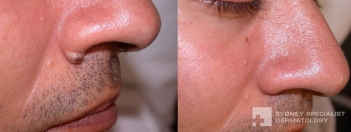Removal of Naevi (Moles)
For what reasons are naevi (moles) removed?
Naevi may be removed because they are suspicious of skin cancer, or because they are catching on clothing, or the patient simply dislikes their appearance. In the latter case it is important that the lesion is of a type and in a position that will likely result in an improved cosmetic appearance after removal.
What techniques are available for removing naevi (moles)?
The two most common techniques used to remove naevi are 1) shave-excision and 2) full thickness excision and suturing. Depending on the site and type of naevus, one technique may be preferred over another.
Shave-excisioin involves simply shaving a lesion flat with the surrounding skin. This technique is preferred for many colourless moles on the face. With shave-excision, the entire lesion is usually not removed and there is a small chance that the lesion will slowly regrow over years. If this occurs, you may either repeat the shave-excision or proceed to a full thickness excision and suturing.
Full thickness excision involves cutting a diamond or ellipse shape of skin including the lesion to be removed and then suturing the wound in two layers. Certain sites such, especially those where the skin is thin and not tight, heal very well with this technique. Typically the suture line needs to be three times as long as the lesion to allow it to heal flat and neatly. Obviously the most precise suturing materials and techniques are used to optimise the cosmetic outcome. Post-operative Fraxel laser may be used to help minimise the scar.










































